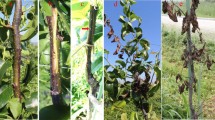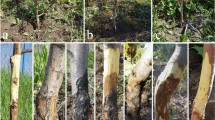Abstract
In the summer of 2008, a brown spot disease in cultivated tree peony Paeonia suffruticosa was found in Shandong Province, China. The causal fungus was isolated from diseased leaves and identified as Cylindrocladium canadense J.C. Kang, Crous & C.L. Schoch based on morphological and molecular phylogenetic studies. Inoculation of the peony leaves with the isolated fungus resulted in similar symptoms, demonstrating that the disease is caused by this species. This report is the first of a disease on tree peony caused by C. canadense in China.


Similar content being viewed by others
References
Chen KS, Li F, Xu CJ, Zhang SL, Fu CX (2004) An efficient macro-method of genomic DNA isolation from Actinidia chinensis leaves (in Chinese with English summary). Hereditas 26:529–531
Crous PW (ed) (2002) Taxonomy and pathology of Cylindrocladium (Calonectria) and allied genera. APS Press, St. Paul
Crous PW, Groenewald JZ, Risède JM, Simoneau P, Hywel-Jones NL (2004) Calonectria species and their Cylindrocladium anamorphs: species with sphaeropedunculate vesicles. Stud Mycol 50:415–430
Felsenstein J (1985) Confidence limits on phylogenies: an approach using the bootstrap. Evolution 39:783–791
Hirooka Y, Ishikawa S, Takeuchi J, Horie H, Nakayama K, Koitabashi M, Okuda S, Natsuaki KT (2009) New cylindrocladium diseases of strawberry and coral bells caused by Cylindrocladium canadense. J Gen Plant Pathol 75:83–86
Juzwik J, Honhart C, Chong N (1988) Cylindrocladium root rot in Ontario bare-root nurseries: estimate of spruce seedling losses. Can J For Res 18:1493–1496
Kang JC, Crous PW, Schoch CL (2001) Species concepts in the Cylindrocladium floridanum and Cy. spathiphylli complexes (Hypocreaceae) based on multi-allelic sequence data, sexual compatibility and morphology. Syst Appl Microbiol 24:206–217
Kumar S, Tamura K, Nei M (2004) MEGA 3: integrated software for molecular evolutionary genetics analysis and sequence alignment. Brief Bioinform 5:150–163
Pan LL, Dai M (2009) Paeonol from Paeonia suffruticosa prevents TNF-α-induced monocytic cell adhesion to rat aortic endothelial cells by suppression of VCAM-1 expression. Phytomedicine 16:1027–1032
Schoch CL, Crous PW, Wingfield BD, Wingfield MJ (1999) The Cylindrocladium candelabrum species complex includes four distinct mating populations. Mycologia 91:286–298
Vujanovic V, St-Arnaud M (2005) Root rot of black spruce caused by Cylindrocladium canadense in eastern North America. Plant Dis 89:204
Xie Y, Zhou H, Wong YF, Xu HX, Jiang ZH, Liu L (2008) Study on the pharmacokinetics and metabolism of paeonol in rats treated with pure paeonol and an herbal preparation containing paeonol by using HPLC–DAD-MS method. J Pharm Biomed Anal 46:748–756
Acknowledgments
This study was supported by a grant from MST (Ministry of Science and Technology) in China (2005DKA21207-19).
Author information
Authors and Affiliations
Corresponding author
Rights and permissions
About this article
Cite this article
Li, N., Zhao, X.L., Liu, A.X. et al. Brown spot disease of tree peony caused by Cylindrocladium canadense in China. J Gen Plant Pathol 76, 295–298 (2010). https://doi.org/10.1007/s10327-010-0245-2
Received:
Accepted:
Published:
Issue Date:
DOI: https://doi.org/10.1007/s10327-010-0245-2




